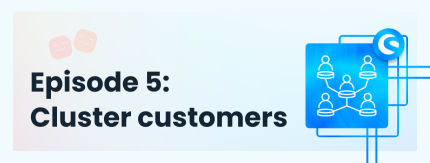
Some talk about personas, others about target groups, and some companies work with milieu studies or generation models. Everyone tries to cluster customers and simplify them through systematics. What systems are there, what are their benefits and how can you represent your customers and their needs? In our blog series called "Customer Happiness Circle", Johannes Altmann provides valuable tips on customer focus and customer satisfaction. This time, it`s all about customer clusters.
It’s all too easy to claim that our business is “customer-focused” – but, in reality, we all know that things are rarely that cut and dried. Who is our customer, what does that customer want, and when, where, and how do we need to focus on them? Do we really have to ask what our customers think about these questions? Market research is way too expensive.
And by the time the project’s underway and we’re bogged down in all the ASANA and Jira tickets and the Trello boards, the customer is nowhere to be found. While they were there at the kickoff workshop, we have slowly lost sight of them. I’ve seen this happen in hundreds of projects and tried to work out why. In today’s Customer Happiness Circle, I’m going to share my conclusions with you and give you my take on how to resolve the issue.
Why we focus too little on our customers
A study has shown that business managers spend just 5% of their time dealing with actual customer issues. I’d be happy to bet that the same goes for product owners and project managers too. The project timeline and budget are center stage – not the customer. But if we want happy customers, it’s important to keep three rules in mind throughout:
Don’t lose sight of the customer
Don’t see the customer as the project
Always meet customer expectations
Unexpectedly overdelivering on expectations would be the ideal, but I’m not really going to touch on that here – we already have more than enough on our hands with points 1 to 3. Throughout my entire career, I’ve only ever come across one dedicated Customer Happiness Manager – someone who was far more than a service employee and significantly more than a member of the CRM team. A post like that can only exist in a business that has examined and understood the goal. This aside, there can be a number of reasons why things aren’t going right for your business and why customers aren’t satisfied with or impressed by the experience you’re offering.
4 drastic reasons:
The business is too siloed, and there is no consistent concept of the customer
There is no proper mindset in the business – the customer’s role is simply ignored
There is no clear commitment on the part of management
No one is responsible for customers or acts as their ambassador
An eye on the customer
You need to have an eye on the customer at all times. But since you can’t focus on each individual customer and everyone in the business has a different idea of the customer, there are models you can draw on. One of the best-known approaches is to use personas.
Personas
Personas are fictional characters that are based on real customer data and market research. They are used to represent a specific target group. They describe the characteristics, needs, motivations, and behavior of the customers. I don’t want to go into a lot of detail here because you can find endless posts about personas online. For me, they are a little like “pigeonholes” that you fill with customer insights.
Sinus-Milieus
Sinus-Milieus are equally interesting, although they tend not to be so widely used in your average ecommerce project. The Sinus-Milieu model is a sociological model that divides society into different socioeconomic milieus. It outlines the different value systems, lifestyles, consumer habits, and social relationships of people in Germany and serves as a basis for market research and marketing strategies. The model is based on a combination of education, profession, and income and assigns the population to seven milieus – for example “Traditionals”, “Hedonists”, or “Digital Natives”.
Lifestyles for tomorrow
The Zukunftsinstitut’s “Lebensstile für morgen” (“Lifestyles for tomorrow”) study examines social trends and changes and looks at the lifestyles people are likely to lead in the future. The study describes these lifestyles in a great deal of detail, and you’ll quickly see yourself reflected in its pages. I find this study far more pragmatic than Sinus-Milieus, and it keeps on delivering new perspectives. I buy every new edition and devour it like a crime novel.
Generation models
The generation models, which define different generations in general terms, are, of course, much more widely known. There’s been a particular focus on Generation Z in this respect, and it’s cited in a large number of studies. But if you know your customers’ age, that absolutely gives you a certain insight that will help you better understand them.
Traditionalists
Traditionalists – also known as the “Silent Generation” – were born between 1922 and 1945 and experienced war and its aftermath in their childhood and youth. They are often described as disciplined and dutiful, and often still have traditional values and a traditional work ethic.
Baby boomers
Baby boomers were born between 1946 and 1964 and were the first postwar generation after the Second World War. They lived through the economic miracle and are the cohort with the highest birth rate. This generation is often described as confident and optimistic and has had a major influence on culture and politics.

Generation X
Generation X, also known as “Gen X” and commonly referred to in Germany as “Generation Golf”, was born between 1965 and 1979. Their childhood was strongly affected by the economic crisis and a rising divorce rate. This generation is often described as pragmatic and independent and often has a skeptical attitude towards authority and institutions.
Generation Y
Generation Y, also known as “Millennials” or “Gen Y”, was born between 1980 and 1993. They witnessed the turn of the millennium and witnessed the internet boom and globalization. In contrast to previous generations, they tend to have a high level of education and often have a positive attitude towards technology and social engagement.
Generation Z
Generation Z, also known as “Gen Z”, was born between 1994 and 2010. This generation grew up with digital technology. They are often seen as tech-savvy and multicultural. They usually have high expectations when it comes to social justice and sustainability and are known for being active on social media.
Gather customer insights
Customer insights are a valuable investment. They provide your business with a better understanding of its customers, helping you to appreciate their needs and preferences. As well as drawing on typical customer models and a variety of studies – both widely known and less so – it’s vital that you invest in your own user research activities. Whether you opt for quantitative polls or qualitative research via surveys, focus groups, and interviews, the knowledge you will gain will form the ideal basis for a customer-friendly business.
It will allow you to develop your own customer models and rely less on ready-made versions – which often fail to offer the degree of detail you need.

7 tips on how to bring customers back to your business:
Work with your team to develop personas. Display the personas around the business, making them a constant presence.
Every time you introduce a new feature or optimization, discuss who you’re doing it for. Your ticket system may even allow you to assign personas.
Establish a customer advisory council that you regularly consult, consisting of 10 to 20 good customers. Invite them to join a Zoom call once a quarter to find out their ideas, gripes, hopes, etc.
Never stop gathering customer insights. Launch surveys, set up focus groups, evaluate reviews and complaints and assign them to your personas.
The persona model is the ideal system for sorting customer insights. It’s important that all the information on the customer is centralized and isn’t monopolized by certain employees or departments.
In meetings, always use personas as the basis for your discussions. “We need XY for Bargain Hunter Smith.”
Continuity, continuity, continuity. Start small and stick with it. It’s a genuine investment in your business!
Wishing you every success with your endeavors to expand your business’s knowledge of its customers and personas. And to help you pursue this in the long term, the next episode of the Customer Happiness Circle will be about the topic of continuity in customer orientation.

All episodes at a glance
Episode 0 – Introduction: Customer Happiness expert Johannes Altmann explains why the subject is so important and outlines the building blocks you can use to inspire your customers.
Episode 1 – Usability: find out how usability errors come about, how you can avoid them, and what impact good usability has on your users’ enjoyment of your store.
Episode 2 – Experience: this episode reveals what impacts customers and offers you inspiration to conjure up an unforgettable shopping experience.
Episode 3 – Brand belonging and your online store: in this episode, you'll learn how to make your online store your customers' favorite and create brand belonging.
Episode 4 – Touchpoints: episode four is about touchpoints of your brand that your customers interact with.
Episode 5 – Cluster costumers: what types of systems exist, how can they benefit you, and how can you utilize customer clusters to accurately depict your customers and their needs?
Episode 6 – Continuity: discover how to organize your business to ensure 'We make the customer happy' isn't a fleeting goal, but rather a constant focus on your agenda.










